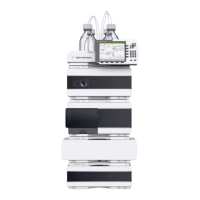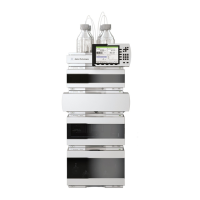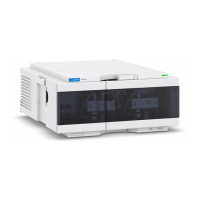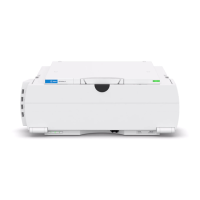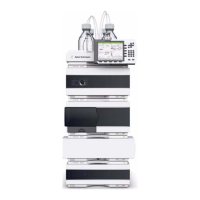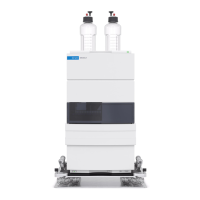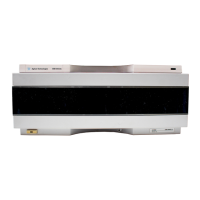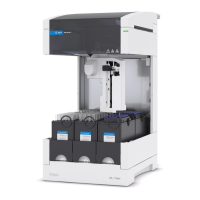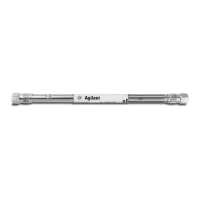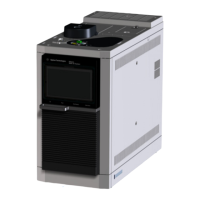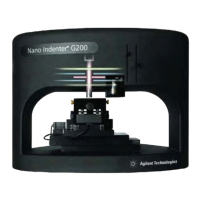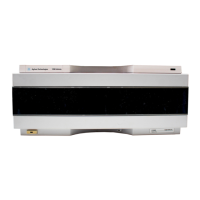
Do you have a question about the Agilent Technologies Infinity Binary Pump VL 1290 and is the answer not in the manual?
| Pump Type | Binary Pump |
|---|---|
| Flow Rate Accuracy | ±1% |
| Gradient Composition Range | 0 to 100% |
| Pump Head | Stainless steel |
| Pressure Range | Up to 600 bar (8700 psi) |
| Power Supply | 100-240 V AC |
| Flow Rate Precision | <0.07% RSD |
| Gradient Mixing Accuracy | ±0.5% |
| Solvent Compatibility | Compatible with a wide range of solvents, including water, methanol, acetonitrile, and buffers |
| Operating Temperature | 4 to 40 °C |
| Flow Rate Range | 0.001 to 5.000 mL/min |
Lists key features of the Binary pump, including seal wash and jet weaver for optimal performance.
Describes the Agilent 1290 Infinity Binary Pump's components and capabilities for high throughput methods.
Explains the dual-piston in-series design and high-pressure mixing for solvent delivery.
Details environmental considerations and power requirements for optimal instrument performance.
Lists physical parameters such as weight, dimensions, and operating conditions.
Outlines performance specifications like flow range, precision, accuracy, and pressure limits.
Provides instructions for unpacking the module and handling damaged packaging or 'defective on arrival' issues.
Guides on arranging modules for optimal performance, minimizing delay volume and bench space.
Step-by-step instructions for safely removing protective foam from the module.
Details the procedure for placing and connecting the pump module to the system.
Explains how to connect tubing and capillaries for solvent flow paths within the pump.
Instructions for installing the optional seal wash function for maintaining pump seals.
Best practices for pump setup to ensure optimal performance and longevity.
Discusses problems caused by algae and methods to prevent or reduce its growth.
Guides on configuring the pump using the instrument control interface and software.
Provides procedures for priming the pump system to ensure proper solvent flow.
Details recommendations on solvent use and materials compatibility in the flow path.
Explains system volumes affecting gradient separation and their impact on chromatography.
Guides on adjusting Jet Weaver mixer configurations to optimize system delay volume.
Discusses methods to increase chromatographic resolution by optimizing selectivity and column parameters.
Explains how to import and use solvent calibration data for accurate pump control.
Describes module status indicators, error messages, and diagnostic signals for troubleshooting.
Outlines available tests and their functionality across different user interfaces.
Introduces Agilent Lab Advisor software for diagnostics, calibration, and maintenance routines.
Explains how error messages are displayed and what they signify in case of failure.
Lists generic error messages applicable to all Agilent HPLC modules, with causes and actions.
Provides specific error messages related to pump operation, including causes and suggested solutions.
Overview of available tests based on Agilent Lab Advisor Software and other user interfaces.
Describes the test to determine system leak rate between pump outlet valves and a blank nut.
Explains the test for individual pump head leakage by blocking each head separately.
Introduces user-accessible assemblies for simple repairs without opening the main cover.
Highlights safety warnings related to solvents, electrical shock, and product usage.
Describes maintenance procedures and simple repairs that can be done without opening the main cover.
Instructions for cleaning the module case using a soft cloth and appropriate solutions.
Guidance on installing and tightening fittings and capillaries, with safety precautions.
Procedure for replacing the shutoff valve panel or individual shutoff valves.
Step-by-step instructions for replacing the pressure sensor and its connections.
Procedure for replacing a defective inlet valve, including torque specifications.
Instructions for replacing a defective outlet valve, including torque and seal replacement.
Details the process for replacing the Solvent Selection Valve (SSV).
Guide to changing the Jet Weaver configuration or replacing it for optimized performance.
Instructions for replacing the seal wash pump if it is worn out.
Procedure to release a stuck inlet valve or troubleshoot pressure generation issues.
Step-by-step guide for replacing the pump head assemblies for maintenance.
Instructions for disassembling the pump head for internal part replacement.
Detailed steps for disassembling the primary pump head assembly.
Detailed steps for disassembling the secondary pump head assembly.
Instructions for reassembling the pump head assembly using alignment tools and torque.
Procedure for replacing the purge valve head and its connections.
Guide for replacing filter frits and seal caps in the high pressure filter assembly.
Instructions for installing the valve rail kit for external valve mounting.
Procedure for replacing the main power fuses, including safety precautions.
Steps for upgrading or downgrading the module's firmware using update tools.
Instructions for preparing the pump module for shipping or transport, including protective measures.
Lists common maintenance parts with their respective part numbers and descriptions.
Details part numbers and descriptions for various capillaries used in the system.
Lists the components included in the solvent cabinet kit for the 1290 Infinity Pump.
Provides part numbers and descriptions for the seal wash pump cartridge and tubing.
Lists parts related to the pump head assembly, including filter, valves, and seals.
Detailed breakdown of parts for the primary pump head, with and without seal wash.
Detailed breakdown of parts for the secondary pump head, with and without seal wash.
Lists the components of the purge valve, including head, stator, and rotor seal.
Details parts related to the module covers, tubing plugs, and valve rail kit.
Lists specific parts related to leak detection and management, such as leak funnels and fuses.
Specifies the part number and rating for the instrument's fuses.
Lists the contents of the accessory kit, including tubing, wrenches, and syringes.
Lists miscellaneous parts including pump service kits and alignment tools.
Provides a summary of different cable types and their uses with Agilent modules.
Details analog cables, including connections to integrators and BNC connectors.
Describes remote cables for connecting to integrators and general purpose devices.
Lists BCD cables and their pin configurations for connecting to Agilent modules.
Information on CAN and LAN cables used for module-to-module communication and network connections.
Details RS-232 cables for connecting instruments to PCs, including pin-out information.
Specifies cables for connecting Agilent 1200 modules to printers.
Explains the instrument's firmware structure, including resident and main system sections.
Details the module's electrical connections, including CAN, REMOTE, RS-232, and power input.
Illustrates the rear panel of the module, showing various connectors and ports.
Provides a table of interfaces available on Agilent 1200 Infinity Series modules.
Initial steps for setting up LAN communication, including noting the MAC address.
Explains the necessary TCP/IP parameters and methods for configuring them.
Details the location and function of the 8-bit configuration switch on the module's rear panel.
Describes selectable initialization modes like Bootp, DHCP, and Using Stored for TCP/IP setup.
Explains DHCP for automatic IP address configuration in HPLC systems.
Guides on setting link speed and duplex modes for LAN interface configuration.
Outlines the process of automatic configuration using the Agilent BootP Service.
Describes manual configuration of parameters stored in non-volatile memory via Telnet or Instant Pilot.
Covers PC setup for local configuration and user interface software installation.
Provides safety symbols, warnings, and precautions for instrument operation and maintenance.
Explains compliance with the WEEE Directive for proper disposal of electrical equipment.
Discusses radio interference and cable usage guidelines to ensure compliance.
Manufacturer's declaration regarding sound pressure emission levels of the product.
Provides the Agilent website URL for the latest product and service information.
